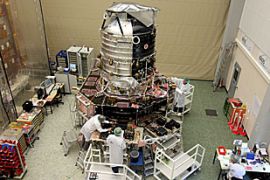Europe launches space telescopes
Two observatories aim to help scientists better understand formation of universe.

Both satellites will be cooled to near absolute zero in order to function.
‘Revolutionary instruments’
Billed by the ESA as “two of the most sophisticated astronomical spacecraft ever built,” the observatories will begin a 60-day journey to the Lagrange point, an orbital slot 1.5m km from earth.
| In depth |
|
|
Speaking at the Kourou launch site, Jacques Louet, head of science projects for ESA, said: “The instruments aboard are revolutionary. They will be using technologies that have never been applied.”
The Herschel telescope will be used to investigate how stars and galaxies form and how they evolve.
By studying infrared light, it will be able to see through clouds of dust that currently obscure astronomer’s view of star and galaxy formation, to illuminate the processes behind them.
It will also examine the dust ejected by dying stars, which spread the heavy elements necessary for life through the universe, as well as analysing the composition of comets and planets in the solar system.
New insights
The Planck telescope will research an even more elemental aspect of astronomy – the period immediately after the Big Bang.
It should provide new insights into how the cosmos came into being, and why it looks the way it does now.
George Efstathiou, a Cambridge University astronomer and member of Planck’s scientific team, said: “In addition to learning the physics of the early universe close to the Big Bang, we are hoping to learn about what will happen to the universe in the future.
“The universe may collapse, expand forever or it may be part of a ‘multi-verse’ and our universe may decay into some different kind of universe. We just don’t know.”
The prime contractor for both spacecraft was Thales Alenia Space, a joint venture company between France’s Thales and Italy’s Finmeccanica.
The launch comes as two Nasa astronauts began the first of five spacewalks to repair and upgrade the Hubble telescope on Thursday.
